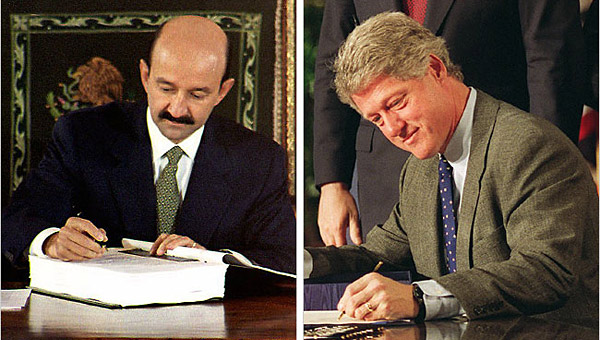
|  |  |  Editorials | Issues | December 2009 Editorials | Issues | December 2009  
Did Nafta Actually Help Mexico?
 Elisabeth Malkin - New York Times Elisabeth Malkin - New York Times
go to original
December 12, 2009


| | Nafta, signed by President Carlos Salinas of Mexico, left, and President Bill Clinton, has been in effect for almost 16 years. (Henry Romero/Reuters) |  |
Who benefited from the North American Free Trade Agreement? Given the continuing decline in American manufacturing jobs, many people assume the winner in the accord must have been Mexico.

Unions and a portion of the Democratic Party have argued that the accord helped push American jobs south of the border to Mexico, where companies can take advantage of low wages and lax regulation. When the issue emerged again last year during the Democratic primary, the benefits to Mexico were never questioned.

But a study released Wednesday by the Carnegie Endowment for International Peace finds that Mexico has fared poorly under the accord.

“After 15 years, it seems clear that Nafta’s promise of broad-based dynamic growth did not come true in Mexico,” write the study’s authors, Eduardo Zepeda of the Carnegie Endowment and Timothy A. Wise and Kevin P. Gallagher of the Global Development and Environment Institute at Tufts.

In one crucial way, Nafta did deliver as expected: Exports and foreign direct investment tripled from the early 1990s as Mexico became a leading supplier of cars, electronics and a broad variety of industrial parts to the United States. Productivity in Mexican manufacturing rose 80 percent.

But annual economic growth averaged only 1.6 percent per capita between 1992 and 2007 — low even by Mexican standards until the 1980s.

The authors blame several problems that contributed to the low growth. While those problems are not exclusively Nafta’s fault, the authors argue that they are part of a broader Nafta-based economic strategy that shunned the public sector’s role in promoting growth.

For example, despite the increase in foreign direct investment, domestic investment decreased.

There are several reasons for this. Local companies went out of business because they could not compete with imports. Foreign companies that invested in Mexico did not source from Mexico, and Nafta’s conditions prevented Mexico from requiring local purchases. At the same time, public investment fell because Mexico adopted strict fiscal policies to achieve macroeconomic stability. The study estimates that Mexico’s overall investment rate has hovered around 19 percent of gross domestic product, compared to China’s rate of about 40 percent over the last two decades.

American jobs did move south, particularly into the export sector. The growth in services — new supermarkets, banks, tourism — also created jobs. But overall, Mexico was unable to create enough jobs to make up for all the jobs lost because of competition from imports, particularly purchases of subsidized grains from the United States.

The oversupply of labor, along with government policies that succeeded in keeping wages low, have led to a slight increase in the gap between average wages in the United States and Mexico — precisely the opposite of what Nafta was expected to do.

The authors conclude that “Mexico locked into place a set of economic policies that collectively produced disappointing results.” Mexico — and other countries seeking Nafta-style trade agreements with the United States — should reframe policies in terms of broader pro-growth strategies that channel the benefits from trade into other parts of the economy, the authors write. |

 |
|  |



